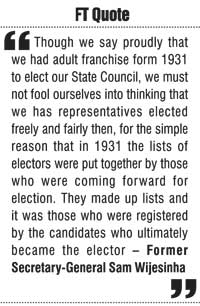Friday Dec 05, 2025
Friday Dec 05, 2025
Saturday, 8 August 2015 00:00 - - {{hitsCtrl.values.hits}}
 With just 10 days more for the general election, the coming week will see the climax of propaganda activity including public rallies, house-to-house canvassing and pocket meetings
With just 10 days more for the general election, the coming week will see the climax of propaganda activity including public rallies, house-to-house canvassing and pocket meetings

With just 10 days more for the general election, the coming week will see the climax of propaganda activity including public rallies, house-to-house canvassing and pocket meetings.
Unlike in the early days when a candidate could concentrate on a single electorate, Proportional Representation (PR or ‘manape’) made an entire electoral district as a candidate’s constituency. Canvassing has thus become much tougher.
Though we consider the granting of universal adult suffrage in 1931 as the starting point of voting to elect people’s representatives, it is interesting to go back to the pre-State Council days when there was some sort of an election to select a stipulated number of members to the Legislative Council.
It was in 1910 that such an election took place for the first time to elect two Europeans, one Burgher and an educated Ceylonese. While the European and Burgher members were elected uncontested, there was a contest for the educated Ceylonese.
The electorate was very limited and mainly barristers, doctors, advocates, surveyors, engineers, volunteer army officers, members of Municipal Councils, those with the Cambridge Senior, Junior or London Matriculation or university students (there were no local universities at the time) were eligible to cast the vote.
Sir Ponnambalam Ramanathan was the first to be elected as the educated Ceylonese. Gradually the number of elected members increased but the franchise continued to be restricted. In addition to education, income also became a pre-requisite to be eligible to vote. 
Former Secretary-General Sam Wijesinha once made an interesting observation on universal adult suffrage when everyone over 21 years of age got the right to vote: “Though we say proudly that we had adult franchise form 1931 to elect our State Council, we must not fool ourselves into thinking that we has representatives elected freely and fairly then, for the simple reason that in 1931 the lists of electors were put together by those who were coming forward for election. They made up lists and it was those who were registered by the candidates who ultimately became the elector.”
Though there were three parties – the National Congress, the Liberal Party and the Labour Party – in 1931, candidates were not nominated by the parties. In fact, there were instances when party leaders supported members of other parties as well. Thus the electors voted for candidates who came forward on their own merit.
Obviously literacy was not at a high level as at present and in order to make voting simple and easy, colours were used in place of symbols. The ballot paper was simple where the voter did not have to mark his preference. After obtaining a ballot paper all he or she had to do was to go into a room where coloured boxes were kept and put it into the box with the colour of his preferred candidate. It was done secretly unlike today when after marking the ballot paper inside a cubicle, it is deposited into the ballot box for everyone to see.
As for the candidates, only those who could read, speak and write English could come forward.
Canvassing too was done in a rather informal way. It is said that the British civil servant H.R. Freeman who had made Anuradhapura is home after retirement, went round and used to sit on a culvert and chat to people. Though not quite fluent in Sinhala he managed to tell them that if they put the ballot paper to the red box he would go to the Council, if it is put to the green box he would go to England! People liked him and saw to him that he is elected to represent them.
The system of candidates representing political parties started in 1947 with the general election for the first Parliament under the Soulbury Constitution.